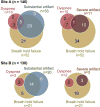An Investigation of Transient Severe Motion Related to Gadoxetic Acid-enhanced MR Imaging
- PMID: 26473642
- PMCID: PMC5562163
- DOI: 10.1148/radiol.2015150642
An Investigation of Transient Severe Motion Related to Gadoxetic Acid-enhanced MR Imaging
Abstract
Purpose: To investigate the cause of imaging artifacts observed during gadoxetic acid-enhanced arterial phase imaging of the liver.
Materials and methods: This HIPAA-compliant study was approved by the institutional review board. Data were collected prospectively at two sites (site A, United States; site B, Japan) from patients undergoing contrast material-enhanced MR imaging with gadoxetic acid (site A, n = 154, dose = 0.05 mmol/kg; site B, n = 130, 0.025 mmol/kg) or gadobenate dimeglumine (only site A, n = 1666) from January 2014 to September 2014 at site A and from November 2014 to January 2015 at site B. Detailed comparisons between the two agents were made in the patients with dynamic liver acquisitions (n = 372) and age-, sex-, and baseline oxygen saturation (Spo2)-matched pairs (n = 130) at site A. Acquired data included self-reported dyspnea after contrast agent injection, Spo2, and breath-hold fidelity monitored with respiratory bellows.
Results: Self-reported dyspnea was more frequent with gadoxetic acid than with gadobenate dimeglumine (site A, 6.5% [10 of 154] vs 0.1% [two of 1666], P < .001; site B, 1.5% [two of 130]). In the matched-pair comparison, gadoxetic acid, as compared with gadobenate dimeglumine, had higher breath-hold failure rates (site A, 34.6% [45 of 130] vs 11.7% [15 of 130], P < .0001; site B, 16.2% [21 of 130]) and more severe artifacts during arterial phase imaging (site A, 7.7% [10 of 130] vs 0% [none of 130], P < .001; site B, 2.3% [three of 130]). Severe imaging artifacts in patients who received gadoxetic acid were significantly associated with male sex (P = .023), body mass index (P = .021), and breath-hold failure (P < .001) but not with dyspnea or Spo2 decrease.
Conclusion: Severe motion-related artifacts in the arterial phase of gadoxetic acid-enhanced liver MR imaging are associated with breath-hold failure but not with subjective feelings of dyspnea or a substantial decrease in blood Spo2. Subjective feelings of dyspnea are not necessarily associated with imaging artifacts. The phenomenon, albeit at a lower rate, was confirmed at a second site in Japan.
Conflict of interest statement
Figures




Comment in
-
Reduction in Respiratory Motion Artifacts on Gadoxetate Acid-enhanced MR Images after Training Technicians.Radiology. 2016 Jun;279(3):981-2. doi: 10.1148/radiol.2016152605. Radiology. 2016. PMID: 27183413 No abstract available.
Similar articles
-
Hepatic Arterial Phase in Gadoxetic Acid-Enhanced Liver Magnetic Resonance Imaging: Analysis of Respiratory Patterns and Their Effect on Image Quality.Invest Radiol. 2016 Feb;51(2):127-33. doi: 10.1097/RLI.0000000000000211. Invest Radiol. 2016. PMID: 26418367
-
Comparison of acute transient dyspnea after intravenous administration of gadoxetate disodium and gadobenate dimeglumine: effect on arterial phase image quality.Radiology. 2013 Feb;266(2):452-61. doi: 10.1148/radiol.12120826. Epub 2012 Nov 28. Radiology. 2013. PMID: 23192781 Clinical Trial.
-
Matched within-patient cohort study of transient arterial phase respiratory motion-related artifact in MR imaging of the liver: gadoxetate disodium versus gadobenate dimeglumine.Radiology. 2014 Jul;272(1):123-31. doi: 10.1148/radiol.14132269. Epub 2014 Mar 8. Radiology. 2014. PMID: 24617733
-
Diagnostic challenges and pitfalls in MR imaging with hepatocyte-specific contrast agents.Radiographics. 2011 Oct;31(6):1547-68. doi: 10.1148/rg.316115528. Radiographics. 2011. PMID: 21997981 Review.
-
Gadoxate disodium: gadolinium EOB DTPA, gadoxetic acid, Gd-EOB-DTPA.Drugs R D. 2004;5(4):227-30. doi: 10.2165/00126839-200405040-00008. Drugs R D. 2004. PMID: 15230630 Review.
Cited by
-
Differentiating Liver Hemangioma from Metastatic Tumor Using T2-enhanced Spin-echo Imaging with a Time-reversed Gradient-echo Sequence in the Hepatobiliary Phase of Gadoxetic Acid-enhanced MR Imaging.Magn Reson Med Sci. 2022 Jul 1;21(3):445-457. doi: 10.2463/mrms.mp.2020-0151. Epub 2021 Apr 20. Magn Reson Med Sci. 2022. PMID: 33883364 Free PMC article.
-
Evaluation of Transient Motion During Gadoxetic Acid-Enhanced Multiphasic Liver Magnetic Resonance Imaging Using Free-Breathing Golden-Angle Radial Sparse Parallel Magnetic Resonance Imaging.Invest Radiol. 2018 Jan;53(1):52-61. doi: 10.1097/RLI.0000000000000409. Invest Radiol. 2018. PMID: 28902723 Free PMC article.
-
Motion and solution in hepatobiliary agent-enhanced dynamic MRI: solid evidence and unanswered question.Jpn J Radiol. 2020 Feb;38(2):99-100. doi: 10.1007/s11604-019-00900-9. Jpn J Radiol. 2020. PMID: 31707630 No abstract available.
-
Per-Feature Accuracy of Liver Imaging Reporting and Data System Locoregional Treatment Response Algorithm: A Systematic Review and Meta-Analysis.Cancers (Basel). 2021 Sep 2;13(17):4432. doi: 10.3390/cancers13174432. Cancers (Basel). 2021. PMID: 34503241 Free PMC article. Review.
-
Image quality optimization: dynamic contrast-enhanced MRI of the abdomen at 3T using a continuously acquired radial golden-angle compressed sensing acquisition.Abdom Radiol (NY). 2024 Feb;49(2):399-405. doi: 10.1007/s00261-023-04035-4. Epub 2023 Oct 4. Abdom Radiol (NY). 2024. PMID: 37792056 Free PMC article.
References
-
- Zech CJ, Bartolozzi C, Bioulac-Sage P, et al. Consensus report of the Fifth International Forum for Liver MRI. AJR Am J Roentgenol. 2013;201(1):97–107. - PubMed
-
- Sirlin CB, Hussain H, Jonas E, et al. Consensus report from the 6th International Forum for Liver MRI using gadoxetic acid. J Magn Reson Imaging. 2014;40(3):516–529. - PubMed
-
- Armbruster M, Zech CJ, Sourbron S, et al. Diagnostic accuracy of dynamic gadoxetic-acid-enhanced MRI and PET/CT compared in patients with liver metastases from neuroendocrine neoplasms. J Magn Reson Imaging. 2014;40(2):457–466. - PubMed
-
- Jeong HT, Kim MJ, Park MS, et al. Detection of liver metastases using gadoxetic-enhanced dynamic and 10- and 20-minute delayed phase MR imaging. J Magn Reson Imaging. 2012;35(3):635–643. - PubMed
Publication types
MeSH terms
Substances
Grants and funding
LinkOut - more resources
Full Text Sources
Other Literature Sources
Medical

